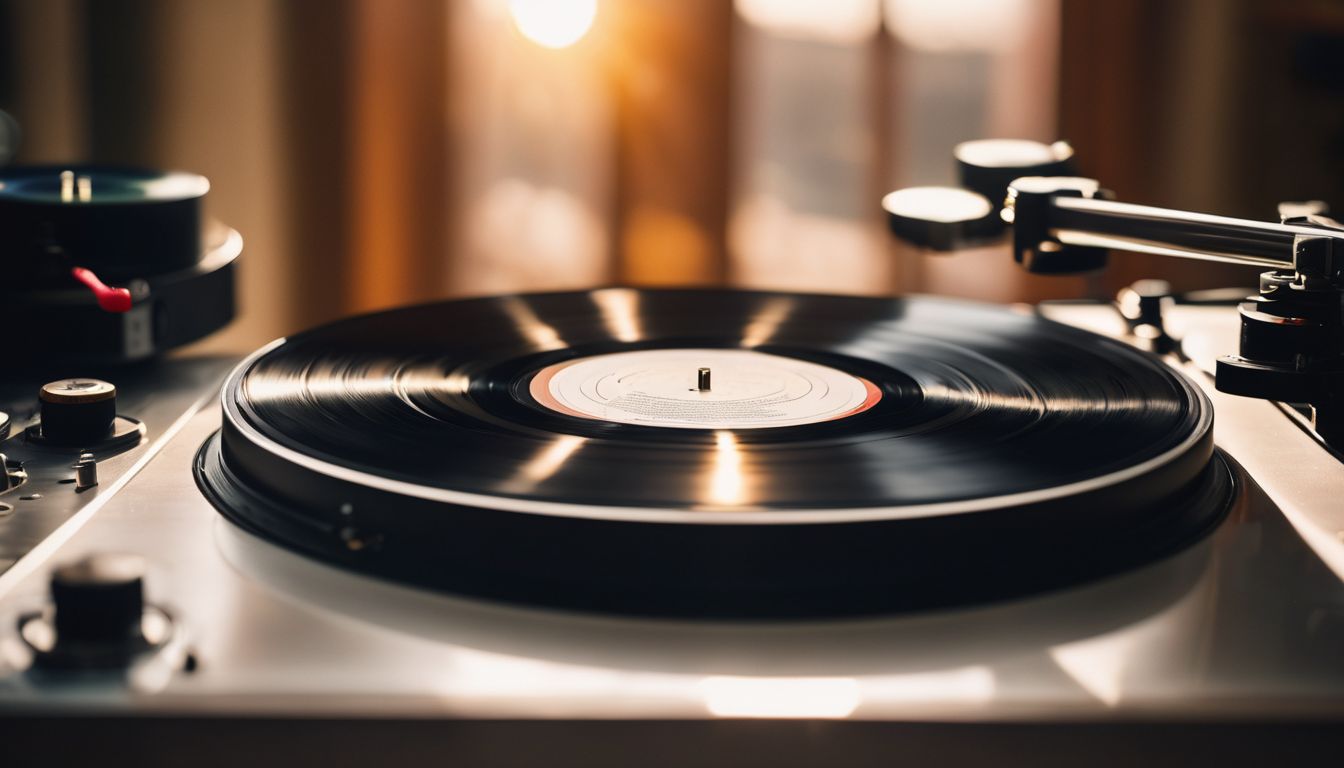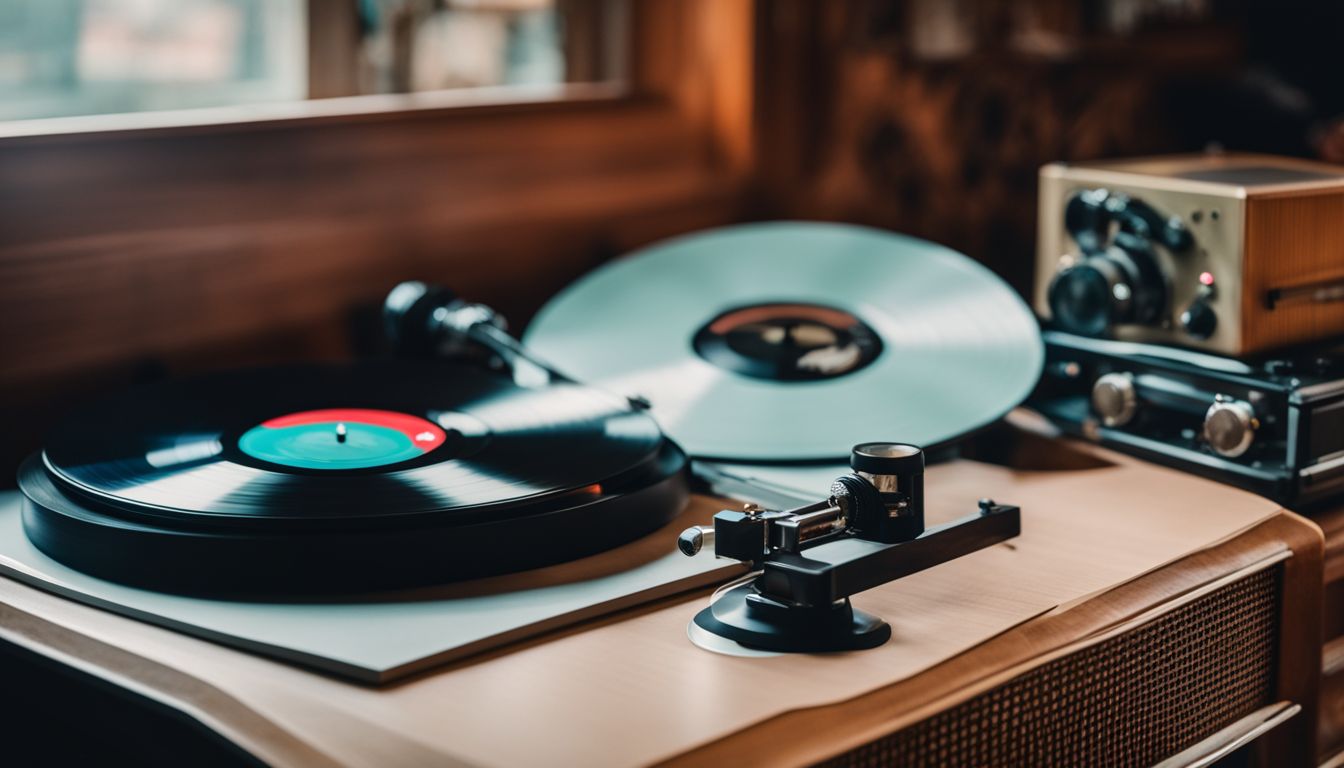If your records don’t sound quite right, the issue might lie beneath them. The turntable platter is where your vinyl records rest, which is crucial for clear playback. Our guide dives into this key component, offering insights to enhance your tunes and keep that needle smoothly cruising the grooves.
Discover the spin-on-better sound below!
Key Takeaways
- A turntable platter is the component where vinyl records are placed and must spin consistently to prevent sound distortions like ‘wow and flutter’.
- Materials used in a platter’s construction, such as acrylic, metal, or composites, can greatly affect audio quality by reducing vibration.
- The turntable mat that lies atop the platter also influences sound by stabilizing the record; choices include felt, cork, rubber, and leather, each with its own acoustic benefits.
- Acrylic platters offer advantages, including better speed stability and dampening of microvibrations for clearer music playback without needing an extra mat.
- Cartridges matter too: moving magnet (MM) cartridges are more common and user-friendly, while moving coil (MC) cartridges provide the higher fidelity preferred by audiophiles.
Understanding the Role of a Turntable Platter
The turntable platter is the heart of any record player, where you place your vinyl for a ride through musical history. It must spin at a consistent speed to avoid ‘wow and flutter‘, which are small variations that can affect sound quality.
A well-designed platter reduces vibration and keeps records stable so each note hits your ears just as intended.
Materials matter; an acrylic platter may offer superior performance over traditional metal ones by damping vibrations even further. DJs favor certain materials for the feel of scratching, while audiophiles might chase after another type for its acoustic properties that enhance their listening experience.
The right choice in a turntable platter can make or break the rich audio landscape you’re looking to explore with each spin of your favorite tunes.
The Anatomy of a Turntable Platter
Delving into the anatomy of a turntable platter reveals the intricacies that shape your auditory experience. This core component not only supports the record but also plays a pivotal role in sound reproduction, ensuring that every beat resonates with precision and clarity.
Plinth, Platter, Slipmat
The plinth is much more than just the stage on which your turntable performs; it’s the solid foundation that holds all of the electronic components necessary for your system to operate seamlessly.
It also plays a crucial role in vibration isolation, ensuring that external tremors don’t interfere with the smooth spinning of your records. Without a stable plinth, you’d likely notice a decline in sound quality, as vibrations can easily turn into unwanted noise.
Moving up from the base, we find the platter, which is directly responsible for cradling your vinyl and contributing to high-fidelity playback. The right platter minimizes wow and flutter measurement discrepancies—those tiny speed variations that can distort audio output if left unchecked.
Above this sits the slipmat, an often overlooked hero in DJing circles. Typically made from felt mats but available in other materials like cork or rubber, slipmats help DJs manipulate records while preventing static electricity buildup and providing yet another layer of defense against resonance that could tarnish your listening experience.
Cartridge: Stylus and Cantilever, Preamp, Tone Arm
Moving from the base elements of a turntable to its sound-producing components, we look at the cartridge, which is key to translating grooves on vinyl into audible music. The stylus, often conical or elliptical in shape, delicately traces these grooves; meanwhile, the cantilever processes minute vibrations into an electrical signal.
Elliptical-shaped styli offer a more accurate read of the record’s intricacies than their conical counterparts.
To amplify these signals to a level your stereo system can use, you might need a preamp. This device steps up the phono output to create rich, dynamic audio that fills your space with sound.
Attached to this process is the tonearm—a pivotal piece ensuring precise tracking and reduced distortion as it holds both the headshell and cartridge firmly in place over spinning records.
Its balance between flexibility and stability allows audiophiles to enjoy every nuance of their vinyl collections without skipping a beat or scratching precious records.
Moving magnet vs. moving coil
The cartridge is a pivotal component of a turntable, housing the stylus and converting vibrations into electrical signals. Let’s delve deeper and compare moving magnet (MM) and moving coil (MC) cartridges, which are two prominent types on the market.
| Feature | Moving Magnet (MM) | Moving Coil (MC) |
| User-replaceable stylus | Yes, easily replaceable | No, often requires professional service |
| Output level | Higher output, typically compatible with standard phono inputs | Lower output may require additional preamp or step-up transformer |
| Sound quality | Very good, with a wide range of options available | Generally superior, they are often preferred by audiophiles for their detail and accuracy |
| Cartridge weight and compliance | Heavier, high compliance, suitable for a variety of tonearms | Lighter, low compliance, requiring more precise tonearm matching |
| Cost | More affordable and popular among casual listeners and enthusiasts | More expensive, considered an investment for serious vinyl collectors |
| Amplification needs | Often compatible with built-in preamps | Typically requires a specialized phono preamp |
| Durability | Robust design, longer stylus life | Due to its delicate design, stylus tends to have a shorter lifespan |
Understanding the distinctions between MM and MC cartridges greatly influences the customization of one’s listening experience and the overall sound quality produced by a turntable.
Exploring the Turntable Plinth: The Foundation of Your Music Experience
A strong turntable plinth provides stability and support, isolating the intricate components above from unwanted vibrations. Its construction is critical, as it houses everything from the motor to the tonearm assembly.
Whether made of dense woods or modern composites, each material adds a distinctive sonic character by damping resonances that could color the music.
Opting for a high-quality plinth can transform your sound system into an audiophile’s dream. Consider how different materials can affect audio performance; some may absorb too much energy, while others might not dampen enough noise.
This balance dictates whether you’ll enjoy crystal-clear sounds or battle with background hums and buzzes during your vinyl sessions. A well-crafted plinth not only elevates musical enjoyment but also serves as an aesthetic centerpiece for any stereo setup.
The Importance of a Turntable Platter Mat
The turntable platter mat is a critical component in the quest for pure, undistorted sound by providing essential damping and stabilizing records as they spin. The turntable platter mat performs silently yet significantly, ensuring that every note and nuance is delivered with clarity from your phonograph to your speakers.
Different types of platter mats: Felt, Cork, Rubber, Leather
Turntable platter mats serve as a critical interface between your record and the turntable platter, greatly influencing sound quality. Each type of mat offers unique benefits that can enhance your listening experience.
- Felt Platter Mat: Felt mats are popular for their affordability and ability to dampen vibrations. However, due to their lightweight nature, they often attract static as well as dust and hair, which can interfere with sound clarity. Their soft texture provides a cushion for records but may require frequent cleaning to maintain top performance.
- Cork Platter Mat: Cork mats stand out by smoothing the contact between the vinyl record and the turntable platter, which can result in an improved audio profile. They absorb vibrations effectively and are known for bringing a nuanced enhancement to sound quality by eliminating unwanted resonance.
- Rubber Platter Mat: Offering impressive stability, rubber mats help prevent records from skipping. The denser material minimizes vibration transmission and is excellent at reducing slippage during playback, ensuring that your music stays on track even when the bass gets heavy.
- Leather Platter Mat: For those seeking durability along with sonic improvements, leather platter mats are an excellent choice. Leather has natural anti-static properties and produces a deep, warm sound that many audiophiles prize. Over time, leather mats conform to the shape of your records, providing personalized support for your cherished collection.
The Benefits of an Acrylic Platter for Turntables
Acrylic platters are a game-changer for vinyl enthusiasts seeking to elevate their audio experience. Their increased density and mass result in enhanced speed stability, ensuring the music plays at a consistent pace without any unwelcome fluctuation.
This stability brings out the best in listeners’ moving magnet cartridges, allowing them to extract every bit of musical detail intended by the artists.
These platters excel at dampening microvibrations that typically interfere with sound quality. An acrylic surface absorbs these tiny disruptions, thereby sharpening the soundstage and providing tighter bass responses.
The clarity of the signal that comes from using an acrylic platter makes listening more immersive, drawing you deeper into your favorite tracks. Furthermore, since acrylic does not require an additional mat like metal platters do, setting up your stereo system becomes less complicated and more aesthetically pleasing.
For those aiming to optimize their turntables, consider incorporating a record weight with your acrylic platter; it’s a combination known to deliver even more noteworthy performance enhancements.
Conclusion
Understanding your turntable’s platter is key to unlocking premium sound quality. Embrace the power of a well-chosen plinth and the precision of an expertly crafted stylus. Remember, a turntable is more than just a machine; it’s the heart of your auditory adventure.
Equip yourself with this knowledge and step into a world where vinyl sings with clarity and depth. Dive deeper into music’s nuances every time you drop the needle on your favorite record!
FAQs
What exactly is a turntable platter?
A turntable platter is the round platform on which you place your record; it spins to produce music when connected to stereo systems.
How does a turnable platter work in a stereo system?
Coils in your stereo system transform the grooves in the vinyl into sound as the platter spins the record at a constant speed and the needle, or pick-up, reads them without being scratched.
Why might my records skip or sound bad on certain turntables?
If your records are skipping or sounding poor, check if the platter isn’t damaged and ensure it’s clean because dirt can affect how well the pickup interacts with your vinyl.
Is there modern technology that uses platters like old stereo systems?
Indeed! Even with streaming and social media platforms for music, many people cherish using turntables for the unique analog sound and tactile experience they offer over digital formats.


